|
Click pictures for a larger version.
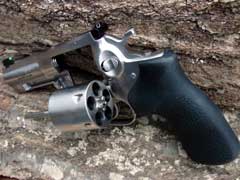
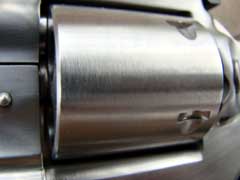
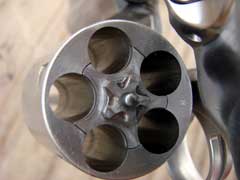
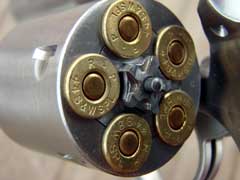

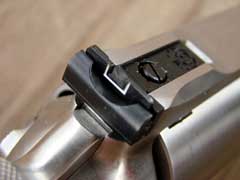
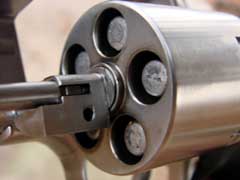
The GP100 has plenty of cylinder length for 250-grain
hard-cast Keith loads.
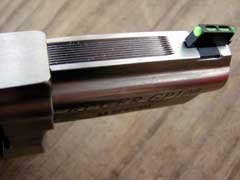
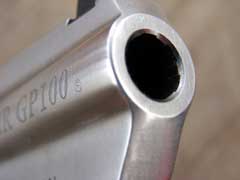
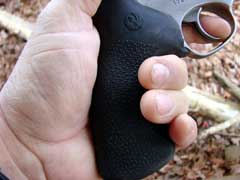
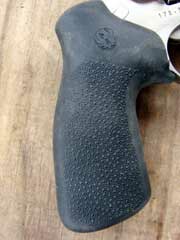
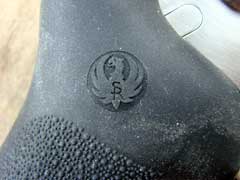
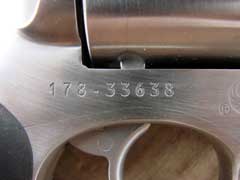
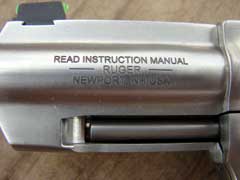
|
|
2016 marks the thirtieth anniversary of the
introduction of the Ruger GP100
double-action revolver.
Introduced as a beefed-up replacement for the excellent
Security-Six line of revolvers, the GP had a very different
internal design, and was built stouter than the Six series
revolvers, while retaining many of its superb features, such as
a no-side-plate frame design, transfer-bar safety, and rugged
internals. Over the past three decades, the GP100 has proven
itself to be a strong, reliable, durable revolver which can take
a steady diet of 357 Magnum
ammunition without failing or needing to be retimed. More
recently, the GP100 was also built
as a ten-shot 22 Long Rifle revolver, and now Ruger has just
introduced the five-shot 44 Special chambering, which has been
requested by many shooters over the years.
The GP100 is of ideal size to easily handle
five 44 Special cartridges, while still leaving plenty of
cylinder-wall thickness for strength and durability. The
cylinder has plenty length to accommodate heavy cast-lead Keith
style bullets, while properly seated into 44 Special cases.
The GP100 44 Special is built primarily of
stainless steel, and wears a three-inch barrel with integral
upper and lower ribs. It wears a Ruger adjustable rear sight
that is mated to a black post front sight with green fiber-optic
insert for greater visibility in various light conditions. I do
expect other barrel lengths and options to be offered later. The
double-action trigger pull is butter-smooth on the revolver
shown here, releasing with just under ten pounds of resistance.
The single-action trigger pull is crisp, releasing with about
four and three-quarters pounds of resistance. The face of the
trigger is rounded and smooth, making for a delightful
double-action shooting experience.
The 44 GP100 balances very well in my hand,
and the synthetic rubber Hogue grip is shaped just right,
affording a secure grasp on the revolver, easily handling the
recoil of stout 44 Special ammunition.
On the subject of ammo, many uninformed
shooters think of the 44 Special as being weak. Using
properly-loaded 44 Special ammunition, not the sissy-level loads
used my many competitors, the 44 Special has plenty of power for
defense and hunting. The “Cowboy
Action” ammunition has its place, and is used in
competition, but serious 44 Special ammunition is readily
available in hollowpoint, wadcutter, semi-wadcutter, and
specialty form which is very effective against flesh and bone.
For hunting and defense, it is debatable whether five shots of
44 Special are better than six shots of 357 Magnum, but now,
shooters have a choice, and for many, the five-shot GP100 is the
gun for which they have been waiting.
Detailed
specifications of the GP100 are listed in the chart below. All
linear measurements are listed in inches, and the weight is
listed in ounces. The trigger pulls are listed in pounds of
resistance. SA is the single-action trigger pull. DA is the
double-action trigger pull. Height includes the sights.
| Chambering |
44 S&W Special |
| Weight |
35.4 ounces |
| Barrel Length |
3.06 inches |
| Trigger Pull SA |
4.6 pounds |
| Trigger Pull DA |
9.8 pounds |
| Cylinder Length |
1.601 inches |
| Cylinder Diameter |
1.58 inches |
| Chambers |
5 |
| Overall Length |
8.5 inches |
| Overall Height |
5.9 inches |
| Barrel / Cylinder Gap |
0.007 inch |
| Sights |
Adjustable Rear / Fiber
Optic Front |
| Safety |
Internal Transfer Bar |
| MSRP as of December 2016 |
$829.00 US |
I fired the GP100 with a variety of 44
Special ammunition that I had available to me. Most of my 44
Special shooting is done with a handload that is loaded to
moderate levels. If I want magnum velocities, I use a magnum, so
in my Specials, is use a load that is very accurate, and still
has plenty of power for whitetail and hogs. It uses a 250-grain
hard-cast lead Keith bullet atop 4.8 grains of Hodgdon Titegroup
powder with a standard primer. The load has light recoil, is
very efficient, and is fun to shoot. The two loads which I like
to carry in defensive revolvers are the Lehigh
Defense Extreme Penetrator solid copper bullet and the
Buffalo Bore soft lead hollowpoint. Both work well in
short-barreled 44s, are accurate, and have proven one hundred
percent reliable. Velocities are listed in the chart below.
Velocity readings were taken at ten feet from the muzzle, at an
elevation of 541 feet above sea level. Temperatures hovered
around the seventy-degree Fahrenheit mark with humidity in the
fifty-four percent range during testing. Velocities are listed
in feet-per-second (fps). Bullet weights are listed in grains.
JHP is a jacketed hollowpoint. LHP is a soft lead hollowpoint.
Keith is a hard-cast lead semi-wadcutter.
| Ammunition |
Bullet Weight |
Velocity |
| Lehigh Defense Extreme Penetrator |
220 |
719 |
| Buffalo Bore JHP |
185 |
1028 |
| Buffalo Bore LHP |
190 |
1054 |
| Cor-Bon JHP |
165 |
939 |
| Handload Keith |
250 |
727 |
The Ruger proved to be very accurate. At a
distance of twenty-five yards shooting from a handheld, rested
position, the GP would group five shots into less than two
inches, easily. Velocities were very respectable, considering
the revolver’s short barrel and wide barrel/cylinder gap. The
GP100 seemed to be timed perfectly, with no spitting out of the
barrel/cylinder gap nor any other problems. The GP100 is easy to
shoot due to its excellent double-action trigger pull, and easy
to shoot well, due to the highly-visible sights. The fiber-optic
rod in the front works very well against a dark background, yet
the black post makes target work very precise. The front sight
is dovetailed into the integral barrel rib, so it would be easy
to change, if desired. Good sights.
Some might ask, “Why a 44 Special?”, and
that is a good question. The 44 Special is accurate and
reliable, but it is also a good defensive cartridge. The 44
throws a large bullet at moderate velocity, and on paper,
doesn’t look all that impressive. It is much like a revolver
version of the good old 45 ACP. However, on target, whether
inanimate steel or living flesh and bone, the 44 Special gets
the job done. It hits with authority, and penetrates well. If
you are of the school of thought which believes in peppering the
target with a handful of small, fast-stepping bullets, the 44
Special is not for you. However, if you tend towards hitting the
target hard and making a large hole, the 44 just might be your
baby. The 44 Special gets the job done with minimal recoil and
muzzle blast. I carry a 44 Special
in my pocket every day. The Ruger GP100 is a bit large for a
pocket gun, but it fills that gap between pocket gun and heavy
belt gun, and is what has for years been designated a
“big-bore belly gun”. The Ruger GP100 44 Special revolver is
compact, reliable, accurate, and made in the USA.
Check out the extensive line of Ruger
firearms and accessories online at www.ruger.com.
For the location of a Ruger dealer near you,
click on the DEALER FINDER at www.lipseys.com.
To order the GP100 online, click on the GUN
GENIE at www.galleryofguns.com.
To
order quality 44 Special ammunition, go to www.buffalobore.com,
www.doubletapammo.com,
www.luckygunner.com,
and www.midsouthshooterssupply.com.
Jeff
Quinn
NOTE: All load data posted on this
web site are for educational purposes only. Neither the author nor
GunBlast.com assume any responsibility for the use or misuse of this data.
The data indicated were arrived at using specialized equipment under
conditions not necessarily comparable to those encountered by the
potential user of this data. Always use data from respected loading
manuals and begin working up loads at least 10% below the loads indicated
in the source manual.
  
Got something to say about this article?
Want to agree (or disagree) with it? Click the following link to
go to the GUNBlast Feedback Page.
|
|
Click pictures for a larger version.
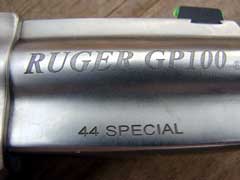

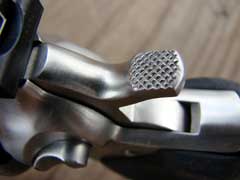
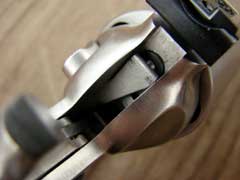
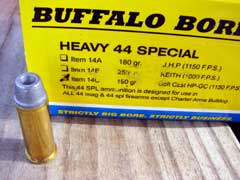
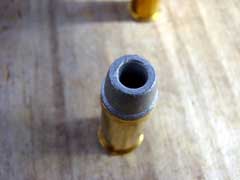
Buffalo Bore
soft lead hollowpoint.
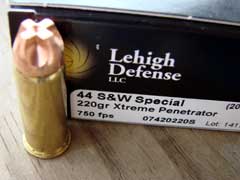
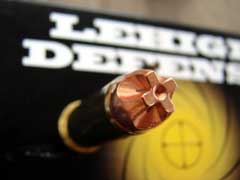
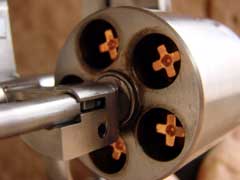
Lehigh Defense Extreme Penetrator copper bullet.
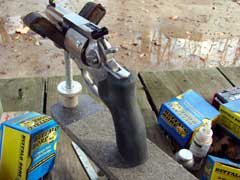
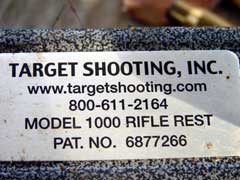
Accuracy testing at twenty-five yards was done with the
aid of a Target
Shooting, Inc. handgun rest.
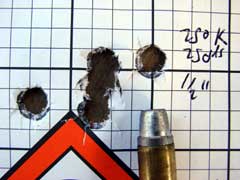
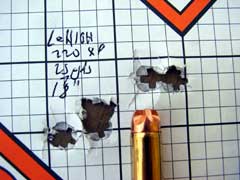
Handloads would consistently group five shots into one
and one-half inches, and the Lehigh Defense ammo did almost as
well.
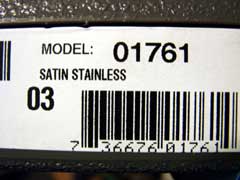
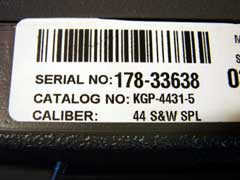
|
![]()